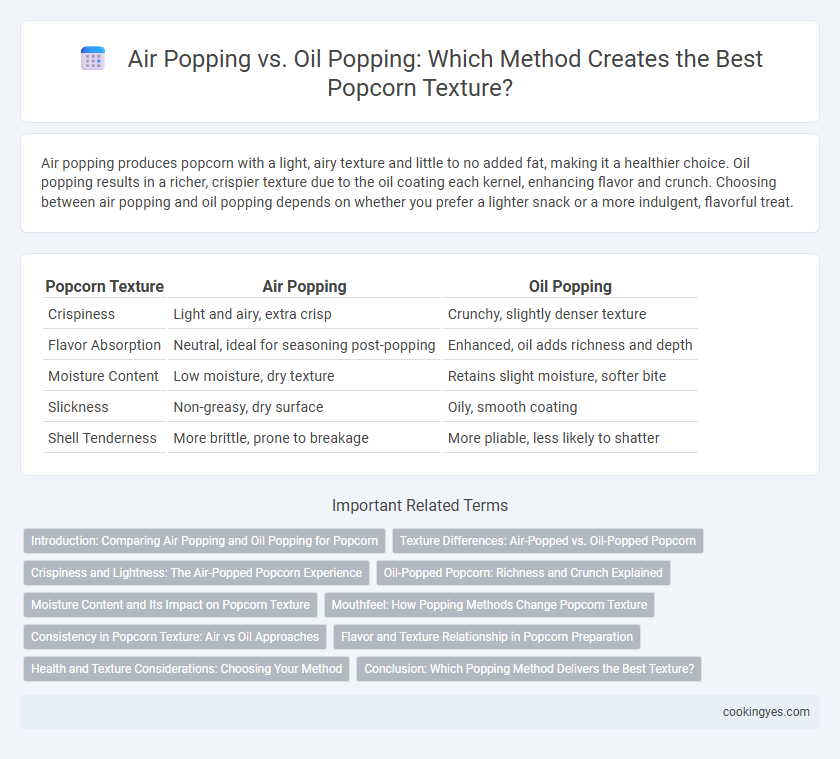Air popping produces popcorn with a light, airy texture and little to no added fat, making it a healthier choice. Oil popping results in a richer, crispier texture due to the oil coating each kernel, enhancing flavor and crunch. Choosing between air popping and oil popping depends on whether you prefer a lighter snack or a more indulgent, flavorful treat.
Table of Comparison
| Popcorn Texture | Air Popping | Oil Popping |
|---|---|---|
| Crispiness | Light and airy, extra crisp | Crunchy, slightly denser texture |
| Flavor Absorption | Neutral, ideal for seasoning post-popping | Enhanced, oil adds richness and depth |
| Moisture Content | Low moisture, dry texture | Retains slight moisture, softer bite |
| Slickness | Non-greasy, dry surface | Oily, smooth coating |
| Shell Tenderness | More brittle, prone to breakage | More pliable, less likely to shatter |
Introduction: Comparing Air Popping and Oil Popping for Popcorn
Air popping popcorn produces a lighter, crispier texture by using hot air to rapidly expand kernels without added fat, making it a healthier choice. Oil popping coats each kernel in hot oil, resulting in a richer, slightly denser texture with enhanced flavor due to the oil's heat distribution and seasoning absorption. The choice between air popping and oil popping depends on desired texture preferences and nutritional considerations.
Texture Differences: Air-Popped vs. Oil-Popped Popcorn
Air-popped popcorn offers a light, crisp texture with a dry surface, making it ideal for those who prefer a less greasy snack, while oil-popped popcorn tends to have a richer, slightly denser texture due to the oil coating which enhances flavor and helps seasonings adhere better. The oil's heat transfer results in a more uniform popping, producing tender kernels with a slight chewiness compared to the often fluffier and more fragile air-popped variety. Texture preference between air-popped and oil-popped popcorn largely depends on individual taste and the desired mouthfeel, with oil-popped popcorn favored for its savory crunch and air-popped for its low-calorie crispness.
Crispiness and Lightness: The Air-Popped Popcorn Experience
Air-popped popcorn delivers a crispier and lighter texture compared to oil-popped kernels due to the absence of added fats that can weigh down each piece. The rapid expansion of moisture inside the kernel during air popping creates a fluffier and more delicate crunch. This method preserves the natural popcorn flavor while offering a healthier, low-calorie snack option with superior crispiness and lightness.
Oil-Popped Popcorn: Richness and Crunch Explained
Oil-popped popcorn delivers a richer flavor and crunchier texture due to the oil coating each kernel, which helps distribute heat evenly and preserves moisture inside the popped corn. The oil creates a crispy outer layer that enhances the popcorn's mouthfeel, providing a satisfying bite compared to air-popped varieties. Popular oils used, such as coconut or canola, also contribute subtle taste nuances while preventing kernels from drying out during popping.
Moisture Content and Its Impact on Popcorn Texture
Air popping popcorn preserves higher moisture content within the kernel, resulting in a lighter, fluffier texture upon popping. In contrast, oil popping introduces external fat that alters moisture evaporation, often producing denser, crispier popcorn with a firmer crunch. The retained moisture level critically influences kernel expansion and texture, with air-popped popcorn offering a more tender bite due to gradual moisture release.
Mouthfeel: How Popping Methods Change Popcorn Texture
Air-popped popcorn offers a light, fluffy texture with a crisp bite, as it expands without added fats, resulting in a drier mouthfeel. Oil-popped popcorn tends to have a richer, crunchier texture due to the oil coating each kernel, enhancing its tenderness and adding a slight grease that contributes to a more satisfying chew. The choice between air and oil popping significantly influences the popcorn's mouthfeel, with oil popping delivering a denser, more pleasurable texture favored in many snack preferences.
Consistency in Popcorn Texture: Air vs Oil Approaches
Air popping creates popcorn with a consistently light and fluffy texture due to the even distribution of heat and lack of added fat. Oil popping delivers a richer, crunchier texture but can result in less uniformity as the heat and oil absorption vary between kernels. Consistent texture in popcorn is more reliably achieved through air popping because it minimizes uneven cooking and oil-induced texture differences.
Flavor and Texture Relationship in Popcorn Preparation
Air popping popcorn produces a lighter, crispier texture with a clean, natural flavor, ideal for those seeking a healthier snack free from added fats. Oil popping infuses the kernels with richer flavor and a slightly chewy texture due to the oil's coating, enhancing overall taste and mouthfeel. The choice between air and oil popping directly influences the balance of popcorn's flavor intensity and texture, tailoring the snacking experience to individual preferences.
Health and Texture Considerations: Choosing Your Method
Air-popped popcorn offers a light, airy texture with significantly fewer calories and no added fats, making it a healthier choice for weight management and heart health. Oil-popped popcorn yields a richer, crispier texture and enhances flavor absorption but increases calorie content and fat intake, which may impact cardiovascular health if consumed excessively. Selecting the popping method depends on balancing desired texture with nutritional goals, where air popping suits low-fat diets and oil popping appeals to those prioritizing flavor and mouthfeel.
Conclusion: Which Popping Method Delivers the Best Texture?
Air popping produces lighter, fluffier popcorn with a crisp texture and fewer calories, making it ideal for those seeking a healthier snack option; oil popping yields popcorn with a richer, crunchier texture and enhanced flavor due to the fat coating. The optimal texture depends on personal preference: air-popped popcorn excels in lightness and crispness, while oil-popped offers a denser, more indulgent mouthfeel. Considering texture alone, many consumers favor oil popping for its satisfying crunch and enhanced taste profile.
Air popping vs Oil popping for popcorn texture Infographic

 cookingyes.com
cookingyes.com